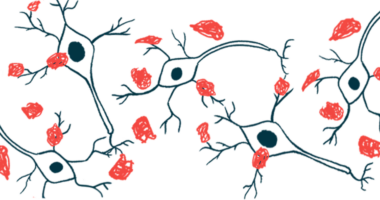Smallest Clumps of Alpha-synuclein Protein Seen to Drive Parkinson’s
Tiny fragments are 'highly toxic' and inflammatory, study finds

Alpha-synuclein protein clumps — the toxic aggregates related to nerve damage in Parkinson’s disease — vary, including in size, and small fragments appear to drive cellular toxicity compared with larger fragments, a study shows.
Its findings were confirmed in post-mortem examinations of brain tissue from Parkinson’s patients, showing smaller clumps were predominantly present.
“Understanding what factors control the size and structure of the aggregates produced in the brain is clearly important to understand what cellular processes fail and lead to the development of [Parkinson’s disease], and may also be related to the patient symptoms,” the researchers wrote.
The study, “Small soluble α-synuclein aggregates are the toxic species in Parkinson’s disease,” was published in the journal Nature Communications.
A diagnostic marker of Parkinson’s is the alpha-synuclein protein that forms toxic clumps, or aggregates, in the brain and spinal cord of patients. As a result, nerve cells that produce dopamine, a molecule that sends messages between nerve cells, are lost, leading to low dopamine levels and characteristic disease motor and nonmotor symptoms.
During the aggregation process, normal alpha-synuclein protein joins with itself to form small, chain-like structures called oligomers, which grow into larger fibers (fibrils) of various shapes and sizes. Because all these different forms of alpha-synuclein aggregates can coexist, it is challenging to identify the specific species of aggregate that confer toxic properties.
Alpha-synuclein protein known to vary in size, structure
Researchers at the University of Cambridge, in the U.K., applied a centrifugation method to separate alpha-synuclein aggregates by size. Then they used imaging to characterize differently sized aggregates, and tested each aggregate size for toxic properties.
Purified alpha-synuclein protein was mixed to initiate aggregation and loaded into a test tube containing increasing concentrations of sucrose sugar (10–50%). When rotated at high speed, larger aggregates are expected to migrate to the highest sucrose concentration at the bottom of the tube, while smaller aggregates remain close to the top at lower sucrose levels.
Imaging analysis confirmed that small alpha-synuclein aggregates could be found at lower sucrose concentrations (20%), and they were predominantly spherical in structure. They were more elongated at higher sucrose levels (30%), and they showed fiber-like species with varying lengths at the highest concentrations (40%–50%).
Differences in the size of these protein clumps at differing sucrose concentrations were statistically significant, the researchers found. The average length of aggregates in the 20% sucrose solution was 190 nanometers (nm), 240 nm in the 30% solution, 290 nm at 40%, and 390 nm at 50% sucrose concentration. (A nanometer is an extremely small measure of size, defined as one-billionth of a meter; for comparison, a human hair is roughly 80,000 to 100,000 nanometers wide.)
Multiple high-imaging resolution analyses also showed aggregates became more fiber-like in structure as they grew in size.
Isolated aggregates of different sizes were added to mouse microglia cells, immune cells within the brain and spinal cord. The team then tested secreted levels of TNF-alpha, a pro-inflammatory immune signaling protein that is strongly implicated in Parkinson’s progression.
Greater inflammatory immune response seen with small clumps
TNF-alpha response was highest when stimulated with the lower 20% sucrose solution, with smaller alpha-synuclein aggregates at an average length of 190 nm. In contrast, larger species found at 40% and 50% sucrose concentrations caused the lowest neuroinflammatory response, while those in the 30% solution generated an intermediate response.
Even smaller aggregates — found at 10% sucrose — produced a similar inflammatory response to the 20% fraction. Moreover, smaller aggregates disrupted lipid cell membranes (fat-like membranes) to a greater extent than larger species, suggesting that “small soluble aggregates rather than fibrils cause greater toxicity,” the researchers wrote.
Post-mortem brain tissue was assessed to confirm these findings. Tissue samples from three Parkinson’s patients and three age-matched controls without neurological disease were processed and underwent centrifugation. Overall, smaller non-fiber aggregates of less than 100 nm were present in Parkinson’s brain samples rather than controls, the study noted.
Small aggregates extracted from Parkinson’s patients also produced a more robust inflammatory response when tested with mouse microglial cells. Analysis suggested that such inflammation was driven mainly by the size — rather than the number — of aggregates.
“We have shown that the small soluble non-fibrillar [alpha]-synuclein aggregates smaller than 200 nm in length are highly toxic species causing lipid membrane [disruption] and inflammation,” the researchers concluded. “In human post-mortem samples, … the soluble aggregates are significantly smaller and more inflammatory than controls.”
Our study “provides evidence that these small soluble aggregates are the critical species driving toxicity in the [Parkinson’s disease] brain,” the researchers added. “Future work will explore the variation in the number and size of aggregates in different brain regions and be performed on a larger number of brain samples.”







